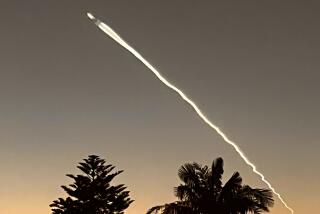Here Be Dragons
- Share via
When the Wright brothers flew the first airplane 101 years ago next month, Orville traveled 10 feet a second for 12 seconds. When NASA flew its unmanned X-43A out over the Pacific from Edwards Air Force Base last week, it traveled 10,560 feet a second for 10 seconds. After humanity spent millenniums dreaming of flight, the invention of aviation by those Ohio bicycle makers opened the hangar on unparalleled changes. More are likely in store with the first flight of the X-43A, which used a revolutionary jet engine devoid of moving parts, called a scramjet, to attain a speed of Mach 10.
Thanks to this pioneering flight, the latest in a continuum of Southern California aviation advances, someday later this century airline passengers and military planners may look back on our 600-mph planes with the same patronizing nods we give to the Wrights’ quaint early contraptions of canvas and wood: “Can you believe that in 2004, people took hours to cross the United States?”
NASA and Boeing engineers took a surfboard-sized wedge of carbon-coated tungsten, crammed it with chemicals and instruments, launched it by rocket from an aging B-52 to 111,000 feet, and flew the thing far faster than any airplane ever, an estimated 6,595 mph. That would go from City Hall to LAX in seconds.
They did it with an intriguingly simple jet-engine alternative, a supersonic combustion ramjet. Once thought unfeasible, the technology uses the craft’s own high-speed airflow to provide the compression and oxygen necessary to burn hydrogen at an intensity to manufacture that familiar jet thrust, only on steroids. The idea of routine hypersonic flight intrigues commercial aviation companies, military planners and those pondering cheaper cargo lifts into Earth’s orbit. Need a parcel in New Delhi by lunch? Troops to Turkey? Imagine less time flying to Europe than checking in and being screened.
Like most inventions, scramjets need work. Something -- a rocket or standard jet -- still needs to boost them to Mach 4 before they can operate. But research quietly continues; less than 24 years elapsed between Kitty Hawk’s dune hops and Charles Lindbergh’s first solo Atlantic leap.
Edwards AFB, 90 miles north of Los Angeles, is often at the center of aviation advances. The X-43A was built at Edwards, then airlifted 120 miles southwest of Long Beach and rocketed up 21 miles to shatter airplane speed records Wednesday, blasting over the Pacific at Mach 9.7. Even its 608-second descent into the sea 850 miles away provided priceless aerodynamic data.
Analysis of that data will take months. It will chart much research, may help your distant grandchildren visit someday and will answer in the affirmative a brand-new old question: If a scramjet falls into the ocean and no one hears it, does it really matter?
More to Read
Inside the business of entertainment
The Wide Shot brings you news, analysis and insights on everything from streaming wars to production — and what it all means for the future.
You may occasionally receive promotional content from the Los Angeles Times.










